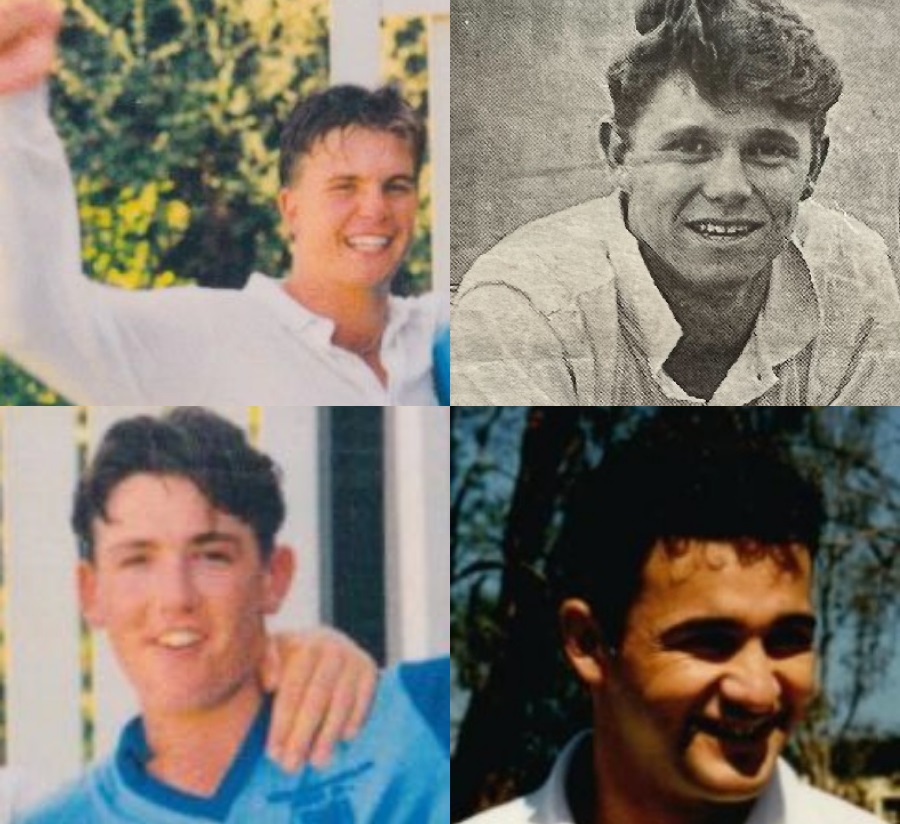Young Guns - Penrith Cricket Club 1991-92
Penrith Cricket Club | April 16, 2023

When management decided in 1988/89 to create, and financially back, a Development Squad for local Junior players aged up to 15, it would train on Tuesday afternoons from May through to August at the St Marys Indoor Cricket Centre. In March, about 30 youngster’s trialled and a squad of 17 was chosen. Head coaches were John Rennie and John Benaud, assisted by other senior players. The immediate aim was to strengthen the AW Green Shield, but long term to unearth players with First-class potential. In other words, a cricket production line.
A stand-out feature of the Development Squad was its balance, which was based around the ‘mix’ of an Ashes Squad. John Benaud had recently been involved in the 1989 Ashes selection and he and John Rennie agreed it was worth trying—a mix of seven bowlers, pace and spin, a minimum of three batsmen with potential to open, five other batsmen, and two keepers. There had to be at least one wrist-spinner in the mix, and all-round potential was encouraged. The coaches also had regard for age; some of the boys were as young as 12, but it was felt they were physically and mentally strong enough to cope against the older boys. The first squad was: Jason Benton, Garry Sheen, Todd Marshall, Russell Holley, Geoff Sullivan, Jason Bishop, Ben Rennie, Scott Roseby, Daniel Abercrombie, Ken Thomas, Brian Starkey, Murray Rayner, Brett Leathen, Brad Astill, Michael Nicholls, Adam Bowyer, Caine Bracken.
John Rennie was the boss. His linkman, or Junior talent scout, was Joe Poulter, who would two decades later become the First-Grade Scorer. At St Marys Indoor ‘JR’ (Rennie) split one net into three, two of which utilised bowling machines and the other was a ‘human net’ (‘live’ bowlers). Another full net was used for fielding drills. The boys were taught batting fundamentals via the machines, and then transferred into the human net to face the real thing, trying to put into practice what they had just been taught.
One of the youngest was Geoff Sullivan, a right-hand middle-order batsman and medium-pace bowler, and, remarkably mature and responsible for his age, traits which later prompted Youth Selectors to rank him captaincy material. ‘Sully’ remembers his St Marys days like this:
“JR and JB at the end of a bowling machine, drilling you with technique, astute defence and aggression, whilst nurturing and encouraging each individual’s unique flair. There was bowling action analysis and correction, fielding technique drills and competitions. But, it was more than just drills and practice. JR and JB had a wealth of cricketing experience and knowledge and each conversation or comment had a cricketing lesson at its heart; reading the game, reading an opponent, setting up a plan, building pressure. They were passionate, even driven, about the proper development of the Junior cricketers in Penrith.
“Part of JR’s program was a Country tour, away from the comforts of home and family, a day-after-day week of intense cricket. These were eye-opening experiences, which again strengthened not only our ability to play competitive cricket, often on turf pitches for the first time, but also to build bonds between players and a sense of ‘team’. I was 14 when we went to Griffith, JR, JB and JP (Joe Poulter) heading the ‘road train’. Our lodgings were modest, dormitory style. I vaguely remember our cricket was reasonable without setting the world on fire. Most interest surrounded our tall left-handed quick bowler named Nathan Bracken. I vividly remember though our games of black-out cricket in our long dormitory room. Lights out, batter at one end, fielders spread and bowler at the other end with … a deodorant-doused flaming tennis ball! Great fun and a great challenge! I also recall learning some very new and colourful words the night our flaming tennis ball so delicately landed into the lap of Joey Poulter … whilst toilet bound! How on earth did it land in there, I wonder?
“My AW Green Shield experience added a lot to my overall cricket education, learning about the many intricacies of the game, especially captaincy. We learnt how to play session cricket, setting goals for each session whether batting, bowling or fielding. We learnt to read individual batsmen and bowlers and how to set plans to bring about their dismissal or how to attack their bowling. It was amazing how often those plans came to fruition.
“I can vividly recall us setting up a talented left-handed opener Nathan Ashley (Balmain and NSW U/17) who in a trial had hooked us continuously to the boundary. After the match, JB and JR wondered if he might be a compulsive hooker. And if he was, could we use it against him?
So, when we played Balmain in the Round we planned for our fast bowler Daniel Abercrombie to direct a couple of short balls from over the wicket, angling across him to make it harder, and riskier, for him to hook effectively, and, hoping he would not be able to hold himself back from playing the shot. Sure enough, a few balls into his innings we had him caught in the deep very cheaply … mission accomplished! JB and JR had very cleverly planted the seed and taught a group of young guys how to execute it.
“Another vivid memory was in a game against Northern District at Cook Park. We had to win to make the Semis so when it had been raining in the days prior and even the morning of the game, things look less than promising for us. When the sun came out, the pitch, whilst covered, turned out to be drenched. The covers had leaked. It was all hands on deck because we needed to play and win! Enter JB and JR and a bit of initiative—I believe we must have bought every spare newspaper in St Marys and covered the whole pitch square and surrounds, treading them down in an attempt to soak up the moisture. We did start the match, but the heavens opened again and the match was abandoned.”
Not only did the Grade Club benefit from the Development Squad concept, so did the Junior Association. In 1989/90 the Junior Annual Presentation was attended by 700 parents and friends of the young cricketers, such was the buzz around cricket. In 1990/91 a NSW Junior Union team toured Darwin and an impressive five members of the Development Squad were selected. They were Jason Benton, who was named captain, Garry Sheen, Matthew Manton, Russell Holley and Shane Greggs. The Foster, Creak, Gee and Weblin teams made the Semi-finals, Foster going on to win their Final, Gee and Weblin beaten in theirs. A new Club, St Clair, was formed. Poulter said in his report: “That area continues to be our greatest breeding ground for junior cricketers.” Four of the best from the early Development Squads were Sullivan, Garry Sheen, Murray Rayner, all of whom won AW Green Shield Player Of The Series Awards, and, Paul Maraziotis.
It was clear to any judge that Murray Rayner was a very, very good left-handed opening batsman even at U/12 Junior level. All the top players have an ego, sometimes referred to as a ‘presence’, and, there can also be a selfish aspect to their game approach, so intent are they on doing their best. Murray had them both, and, ticker and concentration, talent enough to take him much higher than Grade cricket, certainly Shires where he played out his impressive career. He built an imposing record at Penrith: in 1989/90 he won the Club’s Fielding Award, in 1991/92 he was the Poidevin-Gray Player Of The Series. Between 1989/90 and 1992/93 he scored 2229 runs @ 42.86, and took 32 catches. He played NSW U/17 and U/19.
Garry Sheen had brilliance, was tight technically, and could play every shot. He was a top order right-hander, and, the Rookie Of The Year in 1990/91. Ray Hudswell said: “What can you say about a hairy-bummed 14-year-old who arrives in Third Grade and proceeds to steal the show? He endured more sledging from other Clubs than the rest of the players combined. That was a back-handed compliment as he frustrated the opponents with his maturity and talent. Potentially he’s a great player.” Like Sullivan, Garry had already played Colts against the men in 1989/90, when only 13. He played NSW U/17 and U/19, and Australia U/19. Between 1989/90 and 1992/93 he scored 1705 runs @ 37.88, and took 22 catches.
Paul Maraziotis. The clearest sign of the Development Squad’s success was the announcement in 1990/91 of Paul Maraziotis, at just 16, winning the E&W Cammack Outstanding All-rounder Award ahead of more senior Club members. He was in only his second Grade season, started in Fifths, was promoted to Fourths and during the season scored 555 runs, took 20 wickets and eight catches. His bowling type was the most difficult art of them all—left-hand wrist spin. He earned promotion from No.7 in the batting order to No.3 via savvy shot selection and focus, and justified his captain’s confidence with an unbeaten 120 against Parramatta. He was a brilliant gully and slips field. Between 1989/90 and 1992/93 he scored 1333 runs @ 31.73, took 49 wickets at 30.28, and took 22 catches. He played NSW U/19. He was very smart tactically and would go on to captain the Poidevin-Gray.
Tim Sullivan, a Penrith captain, but no relation to Geoff Sullivan, once said of his namesake: “He had an uncanny talent to observe events around him, to listen to all advice, to run the lot through his ‘garbage filter’, then if warranted try it in the nets. He played with the straightest bat, was a great driver with neat footwork and had great hands to the spinners.” Geoff played for the Club’s Colts when he was just 13. Between 1989/90 and 1992/93 he scored 1473 runs @ 27.27, took 22 wickets at 17.40, and took 29 catches. He captained NSW U/17. He would become a Life Member in 2009.








